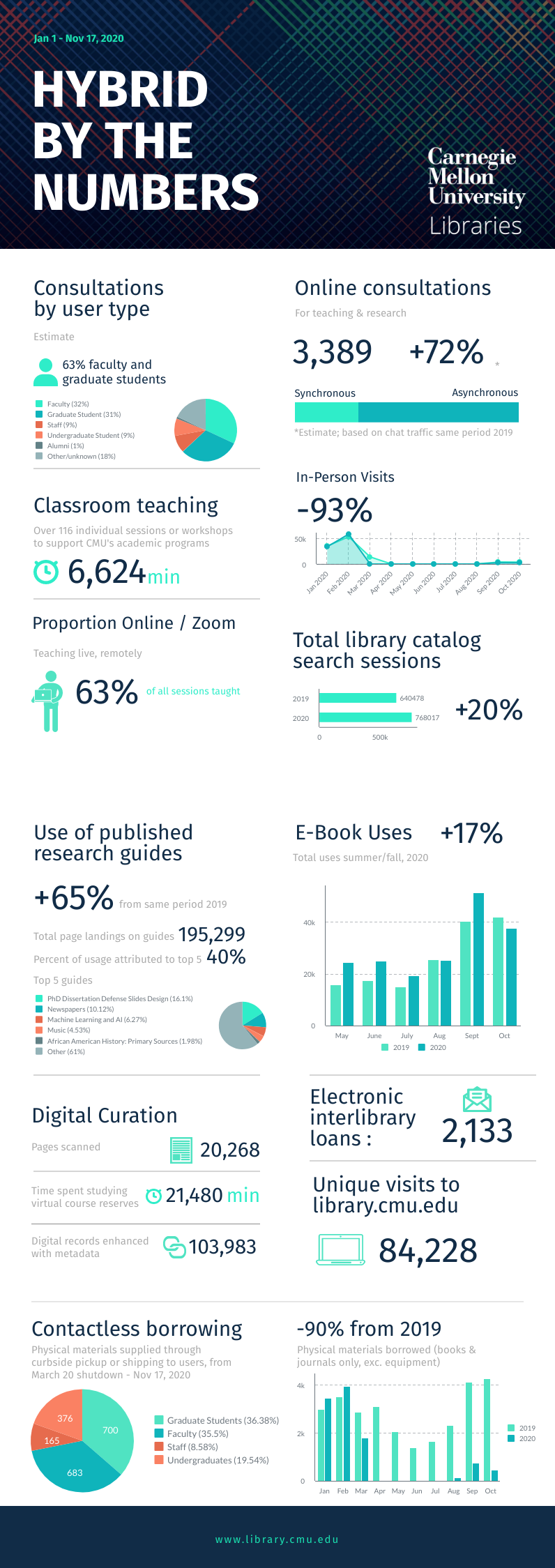After a full year of pandemic operations in support of CMU's hybrid approach to teaching and research, the Libraries' services and the way our faculty and students have utilized them look far different than in previous years.
Here's a brief look at some of the numbers, including some surprises, from our overall year and from the most recent fall semester. Click the image to view a larger version of the infographic.
 First, the hybrid teaching and research environment has clearly posed challenges to our community as they pursue information work. The Libraries' consultations have spiked in 2020. Consultations this year have primarily been offered virtually - either synchronously via our live chat service, or asynchronously via e-mail, with our chat service seeing a large percentage increase in traffic year-over-year.
First, the hybrid teaching and research environment has clearly posed challenges to our community as they pursue information work. The Libraries' consultations have spiked in 2020. Consultations this year have primarily been offered virtually - either synchronously via our live chat service, or asynchronously via e-mail, with our chat service seeing a large percentage increase in traffic year-over-year.
Recent consultations handled by our information specialists across the libraries include:
- Can you recommend tools for automatically identifying similar or duplicated images?
- Can you help me find competitive intelligence on private companies to support a venture competition?
- How can I obtain an English translation of a work in Latin?
- Can my remote students obtain digital access to the textbook for the course I'm teaching?
- I found polling data cited online. Can you help me determine the source, and whether it is legitimate?
- Can you help me develop a search strategy for my work studying policy responses to COVID-19?
- What tools or methods can I use to conduct a gender and sentiment analysis on a large text corpus?
…and many more.
In addition, our information specialists regularly play an active role in offering workshops, trainings, and classroom visits at all program levels to support information skills development across campus. This year has been no different, except that most of that instructional activity has moved online.
In some cases, the remote/online format has yielded unexpected educational advantages. Several of our faculty regularly teach scientific communication and literature search units in the very large lecture sections of MCS' first-year Eureka! course, for instance. While these courses have traditionally been taught in large lecture halls that can accommodate over 100 students, the instructors have often sought to integrate small group activities and hands-on exercises into the instruction. These activities were much easier to facilitate this Fall, utilizing Zoom-based breakout rooms rather than the amphitheater-style, forward-facing seating of the physical lecture hall.
Other changes may last into the future, well beyond the pandemic.
In response to limited access to the library's physical collections, we added 78,294 e-books to our collections throughout the year, with use of e-book content increasing 17% over the same period last year. This is in addition to expanded access to electronic research databases, journals and articles. We also scanned over 20,000 pages of physical content ourselves, supplying remote electronic access to full books, chapters, and articles to faculty and students working and studying from home. As course reserves service has gone virtual and in-house scanning for access has ramped up, new options for requesting and accessing digital content for users have been developed. The convenience and popularity of these new and expanded services indicates they may end up as permanent fixtures.
The enhancement of these digital content and service offerings may partially explain a surprising drop in on-site visitors this Fall. Because the campus and libraries undertook significant efforts to de-densify and reduce seating capacity, we had expected more competition and demand for study spaces and facility access, even with a reduced number of students living and attending classes on campus. As it turned out this semester, we never came close to reaching that reduced capacity for on-site visitors. Over the year, we experienced a 90% decrease in foot traffic in our library buildings.
Looking ahead to Spring 2021
During the long winter break, the Libraries are taking an opportunity to carry out collections and facilities maintenance works before resuming similarly limited on-site services in Spring 2021. We anticipate a hybrid teaching and research environment across the university for spring, that looks and feels much like the fall. With this in mind, we plan to streamline and formalize many of our new digital and remote services, continue to enhance digital content collections, and embark on space planning efforts for library facilities that are responsive to shifts in ways that faculty, students, and library employees will be using our buildings post-pandemic and beyond.
Alicia Salaz, Associate Dean of Research and Academic Services
